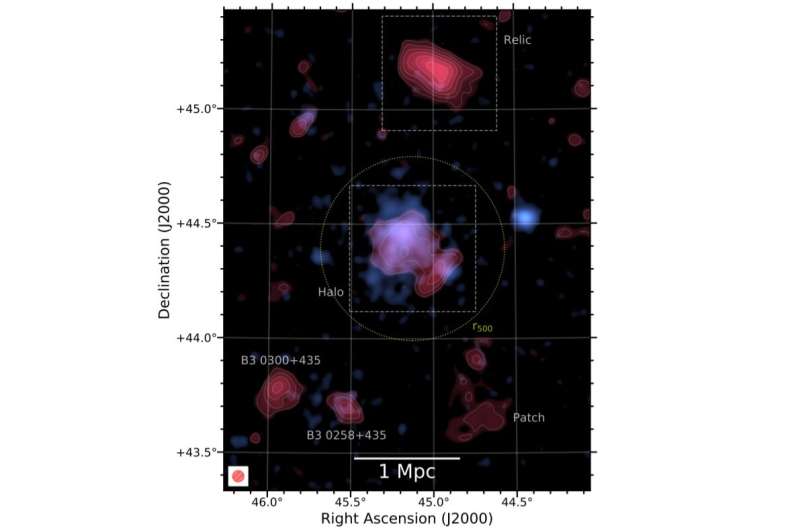Composite radio (LOFAR 120−168 MHz, red) + X-ray (ROSAT 0.1−2.4 keV, blue) image of a 1.6◦ × 2.1◦ field centered on the Ant Cluster. Credit: Botteon et al., 2021.
Using the LOw Frequency ARray (LOFAR), European astronomers have carried out radio observations of a low-mass galaxy cluster known as PSZ2G145.92-12.53, dubbed the Ant Cluster. In result, they identified a radio halo—a feature rarely found in low-mass galaxy clusters. The discovery is reported in a paper published May 28 on the arXiv pre-print repository.
Radio halos are enormous regions of diffuse radio emission, usually found at the centers of massive galaxy clusters. However, diffuse emissions generally have very low surface brightness, particularly at GHz frequencies, which makes them hard to detect. Their brightness increases at lower frequencies, unveiling the presence of these regions.
At a redshift of 0.03, PSZ2G145.92-12.53 is a galaxy cluster with a mass of about 190 trillion solar masses and radio power at 150 MHz of approximately 350 ZW/Hz. Due to its relatively low-mass and weak radio power, the object is nicknamed the Ant Cluster.
Now, a team of astronomers led by Andrea Botteon of the Leiden University, the Netherlands, reports the finding of a radio halo in PSZ2G145.92-12.53. The detection makes the Ant Cluster the least powerful and least massive system hosting a radio halo known to date.
"We have reported the discovery of a radio halo in PSZ2G145.92-12.53 (Ant Cluster) at z = 0.03 using LOFAR observations at 120−168 MHz carried out in the context of LoTSS [LOFAR Two-meter Sky Survey]," the researchers wrote in the paper.
The halo is located in the central region of PSZ2G145.92-12.53 and its morphology follows that of the intracluster medium (ICM) thermal emission. The largest linear size of this halo was measured to be about 2,445 light years.
An in-depth analysis of the radio halo in the Ant Cluster found that the diffuse emission at the center of the cluster is connected to a brighter and elongated structure to the west, that was named the rim. The study revealed that the rim is located in a region of lower gas density, in a direction where the X-ray emission from the intracluster medium has a protuberance.
The observations also detected a source extended in the east-west direction, at approximately 5.5 million light years from the center of the Ant Cluster. The surface brightness of this source drops rapidly to the north direction, while it declines more slowly towards the cluster.
Summing up the results, the authors of the paper underlined how important is LOFAR when it comes to detection of new radio halos.
"Our observations show the potential of LOFAR to detect radio halos even in low-mass systems, where the probability to form them in the context of turbulent reacceleration models is expected to be very low (about 5 percent)," they concluded.
More information: Discovery of a radio halo (and relic) in a M500<2×1014 M⊙ cluster, arXiv:2105.14025 [astro-ph.CO] arxiv.org/abs/2105.14025
© 2021 Science X Network
























